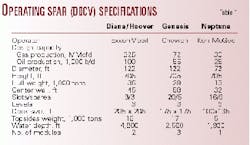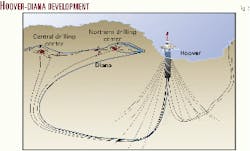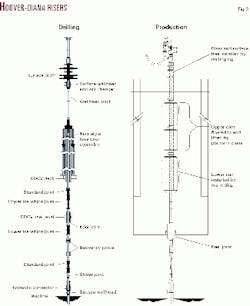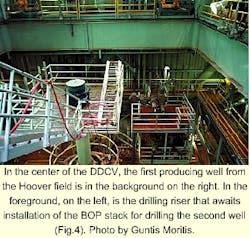Spars or deep-draft caisson vessels (DDCVs) have enabled development of oil and gas production from reservoirs lying beneath great water depths. These floating cylindrical hulls, equivalent in height to about a 75-story building, allow production from both dry-tree completed wells and tiebacks from subsea multifield developments.
ExxonMobil Corp. operates the Hoover-Diana DDCV, the third and heaviest to date of such facilities in the world to handle produced fluids (Table 1). ExxonMobil has a 66.67% working interest in this project with BP holding the remaining 33.33%.
Regarding the difference between the DDCV and spar terminology, Michael E. Flynn, a vice-president of ExxonMobil Development Co. says "ExxonMobil views the term 'spar' to denote a floating structure that stores crude oil. Hoover does not have crude storage capabilities and so we elected to use DDCV to distinguish between a vessel storing crude and one that does not."
First production through the Hoover-Diana DDCV began in May 2000 from subsea-completed wells in the Diana field, 15 miles from the DDCV that is moored in 4,800-ft water over the Hoover discovery (Figs. 1 and 2).
The Hoover-Diana facility has a peak production capacity of 100,000 bo/d and 325 MMcfd. ExxonMobil expects to recover 145 million boe from Diana and 163 million boe from Hoover.
It estimates that total investment in the project will be $1.1 billion. This amount does not include the $160-million, 20 in., 150-mile ExxonMobil Pipeline Co. oil line to Freeport, Tex., or the $86 million, 18 in. by 20 in., 85-mile gas pipeline to El Paso Energy Corp.'s High Island Offshore System that connects to the East Breaks Gathering System.
ExxonMobil says the project established a new world record water depth for a drilling and production platform with an associated subsea development. The surface production trees in this water depth are also an industry first, according to the company.
DDCV
In April 1998, Exxon announced plans to develop Hoover-Diana with a DDCV moored over the Hoover field. It did the front-end work, such as the reservoir evaluation and concept selection, and managed the overall project, contracting out most of the detail design and construction work for the facility.
The DDCV is a cylindrical hull that is buoyed with air-filled compartments in the upper portion and ballasted with seawater and fixed ballast, a slurried hematite, in the bottom compartments. Exxon indicates that it is the heaviest DDCV built to date-51,000 tons total weight, consisting of a 35,000-ton hull and 16,000-ton topsides.
A three-level deck on the DDCV houses separation, dehydration, and treatment facilities along with crew quarters, a drilling rig, and helideck. The decks also house a methanol recovery system, which is the first such system placed offshore in the Gulf of Mexico.
When water production increases from the subsea fields, ExxonMobil expects to need large volumes of methanol to prevent hydrate formation. Currently very little water, about 10-15 b/d, is being produced. ExxonMobil therefore is injecting water to pull methanol out of the produced stream.
Aker Maritime Inc. designed the DDCV and Aker Rauma Offshore handled the hull fabrication work in the Aker Mantyluoto facility in Pori, Finland.
From Finland, the first 15,000-ton hull section of the DDCV was transported to the Aker Gulf Marine fabrication yard near Corpus Christi, Tex. The second 20,000-ton hull section arrived at the yard in June 1999. In Corpus Christi, the two sections were joined before transport to the installation site.
At the site, the DDCV is moored with 12 lines to anchor piles that extend in a radial pattern from the hull. The 7,100 ft mooring lines are connected to anchor piles about 6,900 ft from the DDCV.
The mooring lines are taut but have some flexibility and form a catenary between the hull and seabed.
Once the drilling ends on the Hoover field, ExxonMobil says the loads on the DDCV will become relatively stable. While drilling, the loads can significantly change from such activity as bringing aboard a casing string, requiring the DDCV to be reballasted.
Each mooring line consists of chain, top and bottom sections, and a 6-in. diameter spiral-strand wire rope as the middle section.
The 12 suction-installed anchor piles are 21-ft in diameter by 105-ft long and weigh 275 tons. ExxonMobil says these are the largest suction-installed anchor piles ever used.
Mustang Engineering Inc. designed the topsides, which were fabricated by Brown and Root Energy Services in its Greens Bayou facility, near Houston.
Saipem UK International Ltd. installed the hull, topsides, half of the flowlines, and steel catenary risers. The other half of the flowlines and the export pipelines were installed by Allseas Marine Contractors SA. ExxonMobil indicates that this was the first use of a steel catenary riser for flowlines and export pipelines on a DDCV.
The Saipem lift of the two deck modules, the heaviest at 8,500 tons, represented the heaviest offshore lift, according to ExxonMobil. Heerema's Theilf heavy-lift vessel holds the current record with a 12,856 ton lift on the North Sea Shearwater project.
Solar Turbines Inc. supplied the turbine generators and compressors. Total horsepower on the platform is 81,546, broken down as 62,100-hp turbine, 14,394 hp electric, and 5,070-hp diesel.
Currently, only a small portion of this horsepower is in operation, but most will be needed as the DDCV completes the drilling.
Field development
Exxon, prior to its merger with Mobil Corp., discovered the Diana field in 1990 and appraised it in 1996. It made the Hoover discovery in January 1997.
John Chaplin, production manager US East of ExxonMobil Production Co., says with the oil and gas price scenario of a few years ago, the Diana field by itself would not have been sufficiently large enough to be developed by a DDCV, especially because it is primarily a gas field with a thin oil column. The DDCV concept allows several small projects to be included into a host.
The Diana field covers several lease blocks but is largely contained within East Breaks (EB) Blocks 945 and 989, although some portions are also in Blocks EB 946 and EB 988. FMC Corp. provided the subsea horizontal trees for the Diana field.
All the Diana wells are equipped with downhole and wellhead pressure and temperature gauges and sand monitors.
The Hoover field is in Alaminos Canyon (AC) Blocks 25 and 26, with the DDCV moored in Block AC 25, about 160 miles east of Corpus Christi and 160 miles south of Galveston, Tex.
Transocean's Discoverer 7 Seas drill ship predrilled five of the Diana wells. But to complete the wells, Exxon decided to incorporate the specialized deepwater completion requirement into the new-build Marine Drilling's M700 semisubmersible drilling vessel, which is now drilling nearby deepwater prospects.
The Ensco 26 platform rig is drilling and completing the Hoover wells. When the drilling rig moves between wells, ExxonMobil says, the DDCV is relocated by pulling in/paying out on the mooring lines to position the rig directly over the seabed wellhead. Otherwise, excessive riser wear could occur.
Drilling from the DDCV involves the use of a specially built top-tensioned drilling riser system (Fig.3). Key features include:
- 64 flanged riser joints with syntactic foam to reduce top tension loads. Each 21 in. by 63-ft joint weighs 22,000 lb.
- 9 similar riser joints without foam, weighing 14,000 lb each.
- 60-ft keel joint weighing 62,000 lb.
- 133/8-in inner high-pressure liner installed in the outer riser for deeper drilling operations after 133/8-in well casing is run.
- Ram-style hydraulic-pneumatic tensioner installed on top of the hull supporting the drilling riser with nominal tension of 1.1 million lb in normal operation.
The drilling rig ran and can recover the riser. The riser is designed so that tension can be adjusted during the drilling operation. Also, the design allows the riser to be moved between wells without having to recover it to surface.
For producing the Hoover wells, a production riser is installed to connect the surface tree with the subsea wellhead. The production riser's key features include:
- 75 threaded connector riser joints. Each 133/8 in. by 63-ft joint weighs about 5,000 lb.
- 1 keel joint, 62-ft long and weighing 60,000 lb.
- Tension provided by a set of floating buoyancy cans with seven independent open-bottom chambers. These provide a 1.1. million lb nominal tension.
The crane ship installed the lower 200-ft long riser can, while the platform crane lifted in the smaller upper cans and riser stem. Total length of the cans and stem for each well is 420 ft. The production riser buoyancy cans for all six wells have been installed, but the drilling rig will install the risers and surface trees as wells are completed.
Load cells provide a direct tension measurement of the riser and the can air pressures provide an indirect tension measurement. Nitrogen is used to set and adjust the riser can tension.
The first Hoover well (Fig. 4) was completed at the end of September 2000 and ExxonMobil expects to finish the additional five planned wells in the field by the third quarter of 2001. Each of the Hoover wells will take from 60-90 days to drill.
Surface trees on the DDCV are similar to trees found on traditional platforms. All valves and flowlines are at the surface and are located in the well bay area of the DDCV. These surface trees allow for wellbore intervention with conventional workover technology.
The one Hoover and four Diana wells were producing about 20,000 bo/d and 200 MMscfd in mid October 2000. A complete failure had occurred on the fifth Diana well, and Marilyn Tears, operations superintendent for Hoover-Diana, US East of ExxonMobil Production Co., says plans were being made to repair the well. Evaluation of the cause of the completion failure is in progress.
ExxonMobil completed the first Hoover well with a frac pack and installed a screen and liner. Hoover field completion designs currently call for frac packing the two other conventional wells planned for Hoover and gravel packing the three planned horizontal wells.
The wells will have 41/2-in. tubing and surface controlled subsurface safety valves set at 8,000 ft, some of the deepest safety valves yet installed. All wells are equipped with gas-lift valves
To manage the processes on the platform, ExxonMobil has installed a programmable logical control (PLC) system that it says looks somewhat like a distributed control system (DCS) but is more flexible in that it is modularized, resulting in the benefit that if one module has problems it does not affect operation of the other modules.
Safety record
ExxonMobil is proud of its safety record on the project and claims that it is 12 times safer than the industry.
The US Coast Guard issued the certificate of inspection (COI) on May 26 for the DDCV. The COI is the final Coast Guard regulatory requirement before production from the Hoover and Diana fields could begin.
A temporary COI issued in February 2000 allowed ExxonMobil to occupy the quarters on the DDCV.
The Coast Guard classifies the DDCV as a vessel, and therefore its inspection program verifies that marine systems are built and operated according to safety standards. Carl Kemp, operations manager for the Hoover-Diana, US East for ExxonMobil Production Co., indicated that the Coast Guard has gradually expanded its role as more floating-type vessels, such as tension-leg platforms (TLPs) and DDCVs have been installed in the Gulf.
The Coast Guard had one of its officers oversee the construction and installation process since the vessel arrived at Aker Gulf Marine's Ingleside construction yard. The Coast Guard inspection program primarily centers on inspecting such items as emergency escape routes, equipment safety shut downs, fire detection systems, emergency lighting, and the operational readiness, maintenance, and inspection of lifesaving and fire-fighting equipment.
Also, it inspects onboard environmental protection systems that include spill-containment structures, oily-water separators, and crew sanitation systems.
The Coast Guard requires survival capsule space for twice the number of bunks on the DDCV. Since the quarters with the drilling crew can accommodate 160 people, four 80-man survival capsules are on the DDCV.
The US Minerals Management Service (MMS) is the other government agency that inspected the DDCV. ExxonMobil says it has about 1,200 safety devices on the DDCV that are required by MMS and must be tested.
Operations
ExxonMobil's Kemp, attributes the success of the project to an integrated project team that included both construction and production personnel early in the project.
As an example, he says proper 85-ton cranes which are the "life blood" of the operation were acquired based on operations specifications.
During the construction phase, he says, operating personnel had a lot of time to train on the systems, and also prepare, instead of contractors, the operating manuals for the facility.
After drilling ceases and the drilling rig is removed from the DDCV, about 40-50 ExxonMobil employees (20-25 people/7-day shift) will operate the facility. In addition, the platform has a contract galley crew and a maintenance and touch-up crew.
Kemp says ExxonMobil is one of the few companies in the Gulf that still operates its own fleet of helicopters, and this provides a lot of flexibility to address hurricane evacuation.
Compared to similar sized projects, Kemp says ExxonMobil has about one-half the personnel and attributes these low levels to the uses of a multitasking approach, in which various personnel on the unit acquire competence in a variety of skills.
Future potential
As of mid-August 2000, ExxonMobil's gross lease acreage in the Gulf of Mexico was 3.78 million acres deepwater and 4.54 million acres total. Net lease acreage was 2.97 million acres deepwater and 3.52 million acres total. The numbers of leases were 655 deepwater and 808 total.
The Diana and Hoover fields are among eleven Gulf of Mexico discoveries in water deeper than 1,350 ft that are currently producing or are advancing towards development in which ExxonMobil has an interest.
ExxonMobil has an interest in 33 lease blocks in the Diana basin, including those that encompass both the Hoover and Diana blocks. It says the working-interest owners began acquiring the leases in 1985.
Marshall and Madison are the next fields planned to be connected to the Hoover-Diana DDCV. Support beams are in place on the DDCV for installation of a production module to handle the flow from the three-well remote subsea project. ExxonMobil estimates that production will begin in 2002 from the $200 million project that is expected to produce 15,000 bo/d and 12 MMcfd and recover 47 million boe.
Water depth for the Marshall-Madison development ranges from 4,300 to 4,900 ft. Marshall in Block EB 949 and Madison is in Block AC 24. Both are ExxonMobil-operated fields with 100% ExxonMobil interest.
ExxonMobil also is looking at smaller discoveries such South Diana for tie-in into the DDCV, and says that other small fields could be tied into the DDCV production facility, depending on capacity available.






